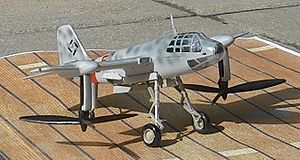Focke-Achgelis Fa 269
This article needs additional citations for verification. (November 2010) |
| Focke-Achgelis Fa 269 | |
|---|---|

| |
| model shown | |
| Role | VTOL aircraft project |
| Manufacturer | Focke-Achgelis |
| Designer | Heinrich Focke |
| First flight | none |
| Primary user | none |
| Number built | 0 |
The Focke-Achgelis Fa 269 was a tiltrotor VTOL aircraft project designed by Henrich Focke.
Development[]
Conceived as a single-seat fighter, the Fa 269 project resulted from a design study order issued by the Reich Air Ministry to Focke-Achgelis in 1941. The order called for a local defence fighter which would combine the VTOL capabilities of a helicopter with the speed and economy of a conventional fixed-wing aircraft.
A large amount of wind tunnel testing was undertaken, along with work on gearboxes, drives and power-pivoting mechanisms, and a full-scale mock-up of the aircraft was built to demonstrate the VTOL concept, but much of this was destroyed by Allied bombing raids and all work was shelved in 1944,[1] when Focke-Achgelis estimated that there was little likelihood of a practical prototype being available before 1947.
Design[]
A mid-wing monoplane, the Fa 269 was to have been powered by a single BMW 801 air-cooled radial engine buried in the fuselage behind the cockpit, which was to have driven transverse drive shafts in the leading edges of the fixed wing, the shafts turning three-bladed rotors via synchronised gearboxes. The plane of rotation of the rotors would have been capable of being swivelled through 80° using angled extension shafts.
It was proposed that the Fa 269 would adopt a high angle of attack when at rest using extremely long undercarriage units. For vertical take-off, the rotors would be lowered till their plane of rotation was parallel with the ground. For translation to conventional flight following take-off, the extension shafts were to pivot to the rear, the rotors then behaving as pusher propellers.[2]
Specifications (Fa 269)[]
Data from Air International, January 1975
General characteristics
- Crew: 1
- Length: 8.93 m (29 ft 3 in)
- Wingspan: 10 m (32 ft 9 in)
- Powerplant: 1 × BMW 801 14-cylinder radial piston
Performance
- Maximum speed: 570 km/h (354 mph, 308 kn)
Armament
- 2 x 30mm MK 108 cannon
References[]
| Wikimedia Commons has media related to Focke-Achgelis Fa 269. |
- ^ Lepage, Jean-Denis G.G. (2009). Aircraft of the Luftwaffe, 1935–1945: An Illustrated Guide. Jefferson, NC: McFarland & Company. p. 385. ISBN 978-0-7864-3937-9.
- ^ Ford, Roger (2013). Germany's Secret Weapons of World War II. London, United Kingdom: Amber Books. p. 224. ISBN 9781909160569.
- Springmann, Enno; Gottfried Hilscher (1997). Focke: Flugzeuge und Hubschrauber von Heinrich Focke 1912-1961. Aviatic-Verlag GmbH. ISBN 3-925505-36-9.
- Nowarra, Heinz (1985–1988). Die Deutsche Luftrüstung 1933-1945. Bernard & Graefe. ISBN 3-7637-5464-4.
- Abandoned military aircraft projects of Germany
- Focke-Achgelis aircraft
- 1940s German experimental aircraft
- Research and development in Nazi Germany
- Tiltrotor aircraft
- Mid-engined aircraft